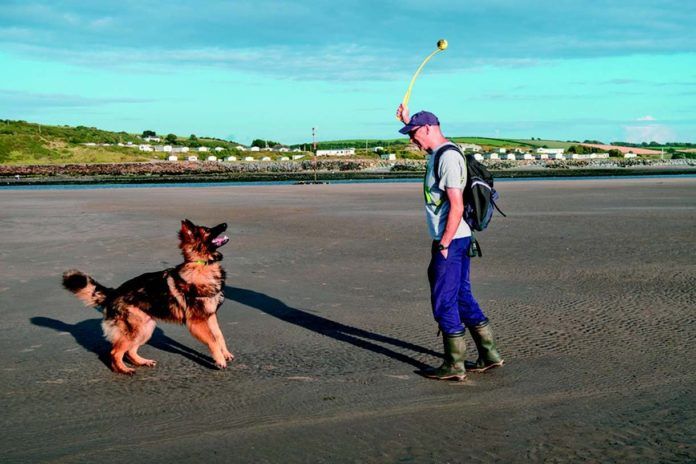So many dogs love those plastic ball chuckers, and why not? They allow a person to fling a ball faster and farther than they could with their arm, affording a pet a happy, frenetic run at top speed in order to chase the ball down and bring it back for more. Some dogs, in fact, are absolutely obsessed with the game.
Their owners love the activity, too, understandably. They believe that repetitive throwing of a ball with a chucker allows a dog with an abundance of energy to finally get tuckered out. Lots of exercise with a ball chucker can even help attenuate aggressive or disruptive herding tendencies, some believe.
The hitch is that all of a dog’s diving, skidding, lurching, and twisting-in-mid-air maneuvers in pursuit of a ball pitched at high velocity poses risks to joints and other soft cartilage serious enough to cause debilitating arthritis and other ills. That diminishes the quality and even the quantity of a beloved pet’s years if the ensuing pain and disability lead an owner to consider euthanasia. The risk is compounded by the fact that owners often don’t consider that dogs, like people, have physical capabilities to consider, current physiological fitness to bear in mind, and at least need exercise warm-ups.
A minimal consideration is to start out a session of intense physical activity with slower runs and easier maneuvers to give the body tissues time to acclimate and warm up, so to speak. This is especially true in cases where owners only have time to take their dogs out for exercise on the weekends. If the dog doesn’t warm up before engaging in intense physical activity, she becomes a weekend warrior, lying around Monday through Friday and then going straight into hardcore, high-impact athletics without any ramping-up activities.
Veterinarian Hannah Capon knows all too well the effects that ball chuckers can have. In fact, Dr. Capon has seen so many everyday activities that we choose to do with our dogs cause more harm than good that the United Kingdom-based animal doctor left her 15-year career as a veterinary surgeon to start Canine Arthritis Management (caninearthritis.co.uk), which educates the public about the risks for the disease. The team of professionals who run the organization compare chasing chucked balls to a drug addiction for some dogs, pointing out that many “will go to great lengths to get a fix,” even ignoring pain that is supposed to signal to them to slow down or stop playing altogether. They point out, too, that arthritis affects some 80 percent of all dogs older than eight years of age, a proportion that isn’t helped by injudicious exercise routines, and that the disease is mentioned both in the UK and the US as one of the top reasons people put their dogs down.
And they suffer before their avoidable deaths. Dogs cope with arthritis pain for years before it becomes too great to hide, Dr. Capon notes, even playing vigorously despite painful joint damage.
How to remedy the situation
If you’re a dog owner whose pet loves to chase chucked balls, how do you redirect his energy from something he loves?
Part of the answer may be to put your pet through more gentle paces before pulling out the ball and to consider just using your arm rather than a chucker, which won’t send the ball out as quickly or as far. Think of how difficult it would be for you to run a relay race at seven miles an hour after you’ve been sitting around in the family room for hours. You’d want to start with brisk walking or slower jogging to acclimate.
Then, even if you do work up to chucking balls for your pet, don’t do it until you sense your dog feels exhausted physically and emotionally. Do it just for a little while, then move on to something else that isn’t so taxing to the body. Your common sense has to trump her momentary happiness. (Note: it is not always happiness but in some cases obsessive behavior that needs to be addressed by a veterinary professional.)
Keep your dog active at home, too, so she’s getting some exercise on a regular basis. That could include everything from gently tossing a ball for her in the yard to giving her a Kong to wrestle with to retrieve her food. Regular physical activity interspersed with some short bursts of more intense exercise here and there is a safer way to go for keeping your pet healthy and happy.





